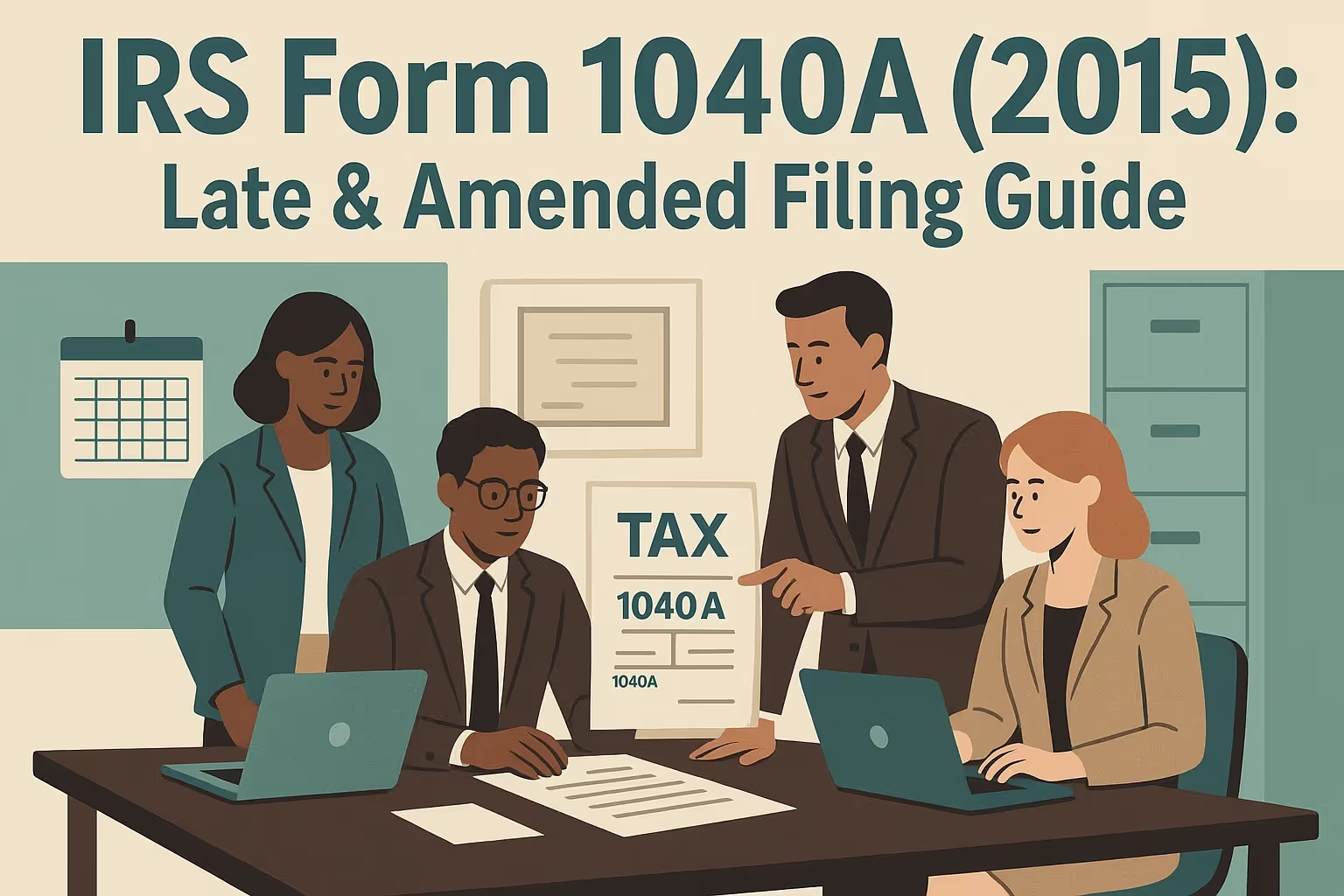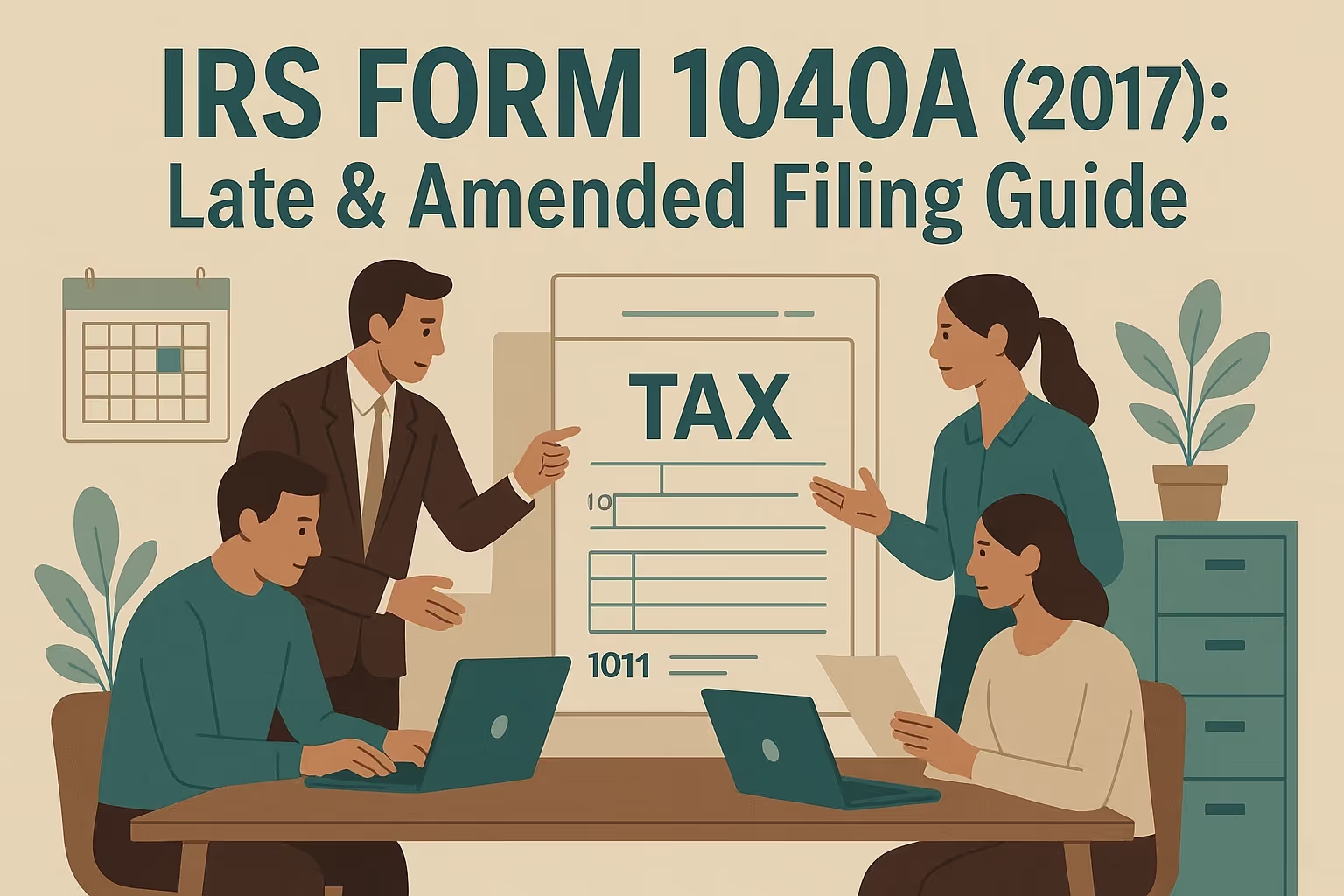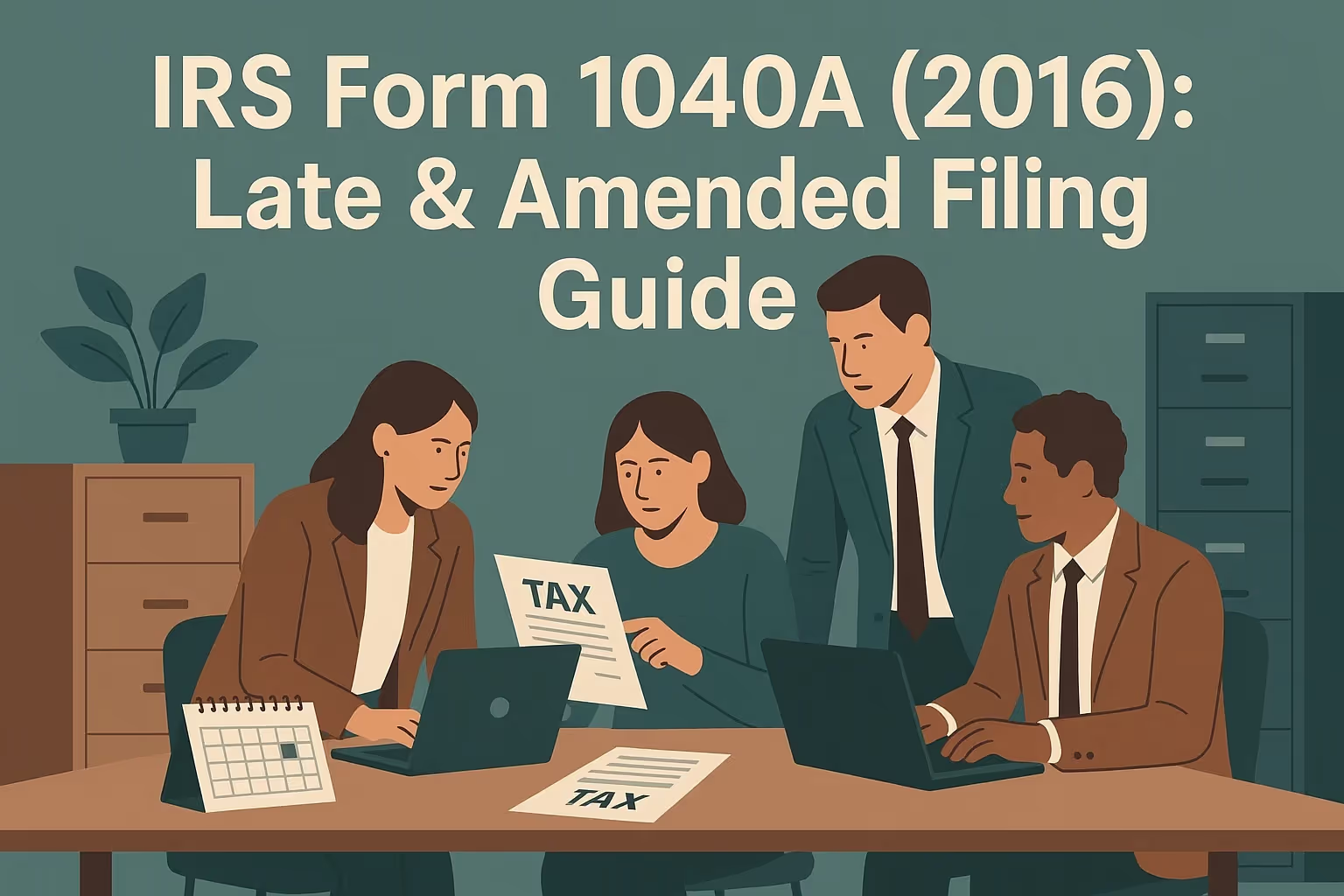Form 1040A 2013 Instructions: Complete Tax Return Guide
Filing taxes can seem overwhelming, but the IRS has provided simpler options for many individuals in recent years. For the 2013 tax year, one of the most widely used forms was Form 1040A, often called the short form. This version of the federal tax return was designed for taxpayers with straightforward financial situations who needed more than the extremely basic 1040EZ but did not require the complexity of the complete Form 1040. Understanding how this form worked helps taxpayers who may need to review old filings, file amended returns, or access accurate tax information for financial records.
Form 1040A allowed eligible taxpayers to report familiar income sources such as wages, dividends, retirement distributions, and Social Security benefits. It also supported several tax credits, including the earned income tax credit, child tax credit, and education credits, which were valuable in lowering overall income tax owed. While deductions were limited to the standard deduction, adjustments such as student loan interest and IRA contributions could still affect adjusted gross income. These features made the form practical for many households below $100,000 during that tax year.
This guide provides complete Form 1040A 2013 instructions, explained step by step, for individuals reviewing their original filing or learning how the process worked. Readers will find details on eligibility, filing status, payment options, common mistakes, and ways to claim refunds correctly. By following these tax tips, taxpayers can better understand the process and ensure their records remain accurate and complete.
What Is IRS Form 1040A?
IRS Form 1040A was a simplified version of the federal tax return available for individual taxpayers through tax year 2017. For the 2013 tax year, it served as the middle ground between the short 1040EZ and the more detailed Form 1040. It was designed for taxpayers with straightforward income sources and limited deductions who still needed the ability to claim several common tax credits.
Key Features of Form 1040A
- The form was only two pages long, making it easier to complete than the full Form 1040.
- It allowed taxpayers to report wages, dividends, retirement distributions, Social Security benefits, and unemployment compensation.
- The form accepted adjustments such as student loan interest, IRA deductions, and tuition and fees.
- Itemized deductions were not allowed, and taxpayers had to use the standard deduction.
- Tax credits included the child tax credit, the earned income tax credit, and specific education credits.
- Taxpayers could use this form only if their taxable income was less than $100,000.
Form 1040A provided an efficient way for many taxpayers to file taxes without unnecessary complexity. It gave access to essential tax credits while streamlining the process for those with qualifying income and deductions. Understanding its purpose helps taxpayers review records or file an amended return for the tax year 2013.
Updates for the 2013 Tax Year
Each tax year brings changes that affect how taxpayers file their federal tax return, and 2013 was no exception. Several updates were applied to those using Form 1040A.
- Legally married same-sex couples were required to use a married filing status, such as jointly or separately, even if their state of residence did not recognize the marriage.
- The personal exemption amount increased to $3,900, which gave taxpayers a slightly larger deduction than the $3,800 allowed in 2012.
- Standard deduction amounts were updated for all filing statuses. For instance, single filers could claim $6,100, while married couples filing jointly could claim $12,200.
- Mileage deduction rates changed for 2013. Business travel could be claimed at 56.5 cents per mile, while medical and moving travel were deductible at 24 cents per mile.
- Taxpayers who received an Identity Protection PIN from the IRS due to prior issues with identity theft were required to include the PIN when filing.
These updates directly influenced the amount of income tax owed or the amount of a refund that could be claimed. Understanding them helped taxpayers avoid errors and take advantage of the correct deductions and credits.
Eligibility Requirements for Filing Form 1040A
Form 1040A had strict eligibility rules. Taxpayers could use this form only if their financial situation fit within specific limits.
Income Sources Allowed
- Taxpayers could report wages, salaries, and tips they received from an employer using Form W-2.
- Interest and ordinary dividends were permitted as long as they came from standard savings or investment accounts.
- Retirement income, pensions, and annuities could be included if the amounts were reported on Form 1099-R.
- Taxable Social Security and railroad retirement benefits were eligible, though special worksheets were sometimes required to determine the taxable portion.
- Unemployment compensation and Alaska Permanent Fund dividends could also be reported.
- Specific scholarships or fellowship grants counted as taxable income could also be included.
Adjustments Permitted
- Taxpayers could deduct up to $2,500 in student loan interest if they met the income requirements.
- Contributions to a traditional IRA were deductible, reducing adjusted gross income.
- Educator expenses of up to $250 per teacher were allowed for qualified school staff.
- Tuition and fees for higher education could be deducted if income fell within the limits.
Credits Available
- The child tax credit was available for each qualifying dependent under age 17.
- Workers who met income and dependent rules could claim the earned income tax credit.
- The retirement savings contributions credit was available to taxpayers who made eligible IRA or 401(k) contributions.
- Education credits, including the American Opportunity and Lifetime Learning Credits, could help offset tuition costs.
- The credit for child and dependent care expenses supported taxpayers who paid for child care while working.
- The credit for the elderly or disabled applied to individuals who met age or disability requirements.
Restrictions
- Taxpayers could only use Form 1040A if their taxable income was less than $100,000 for the year.
- Itemized deductions were not permitted on this form, so only the standard deduction could be claimed.
- Individuals subject to the alternative minimum tax cannot file using Form 1040A.
- Taxpayers with complex financial situations, such as business income or advanced investment activity, must use the complete Form 1040 instead.
Meeting these rules ensured taxpayers could take advantage of the simplified filing process while claiming valuable tax credits.
Step-by-Step Filing Instructions
Completing Form 1040A required careful attention, but following a step-by-step approach made the process manageable.
- Taxpayers first needed to gather all necessary documents, including W-2s from employers, 1099 forms for interest and dividends, SSA-1099 forms for Social Security benefits, and prior-year returns. Bank account details were also needed for direct deposit of refunds.
- On the first page, personal information such as a social security number and address was entered. Taxpayers could also check the box to allocate three dollars to the Presidential Election Campaign Fund.
- The correct filing status had to be selected, with options including single, married filing jointly, married filing separately, head of household, or qualifying widow(er).
- Taxpayers listed exemptions and dependents, providing each dependent’s full name, Social Security number, and relationship. They also indicated whether a child qualified for the child tax credit.
- All income was reported, including wages, dividends, retirement distributions, unemployment compensation, and taxable Social Security benefits.
- Adjusted gross income was calculated by subtracting eligible adjustments, such as student loan interest, IRA contributions, or tuition and fees, from total revenue.
- The standard deduction and personal exemptions were applied to determine taxable income.
- Tax liability was calculated using the IRS tax tables, and eligible tax credits such as the earned income tax credit, education credits, or dependent care credit were applied.
- Payments already made, including federal tax withholding or estimated payments, were entered to determine whether a refund or balance due applied.
- Finally, the return had to be signed and dated. Taxpayers filing electronically used a PIN, while paper filers mailed the completed return to the IRS.
By following these steps, taxpayers ensured their tax return was complete, accurate, and filed on time, reducing the risk of IRS penalties and processing delays.
How to File Form 1040A?
Taxpayers filing Form 1040A in 2013 had two primary methods: electronic filing and paper filing. Each option had advantages depending on personal preferences and access to resources.
Electronic Filing (E-file)
- Taxpayers with adjusted gross incomes of $58,000 or less could file taxes online using the IRS Free File program. This service allowed individuals to prepare and submit their federal tax returns without paying processing fees.
- Many people used commercial tax preparation software like Intuit TurboTax, H&R Block, or TaxAct. These tools guided users through simple questions, performed calculations automatically, and provided audit support options.
- Professional tax preparers and tax experts often handle e-filing for clients. This service was helpful for taxpayers who wanted expert help or had questions about credits, deductions, or income reporting.
Paper Filing
- Taxpayers who mail their return must print or use official IRS forms, sign the documents, and attach necessary schedules and receipts.
- All W-2s and 1099s showing withheld income tax had to be attached to the front of the return. Additional schedules, such as those for child tax or education credits, were organized in a specific order.
- Mailing addresses varied by state and by whether a payment was included. Taxpayers were advised to use certified mail for security and to keep copies of everything they submitted.
Using either method, taxpayers needed to ensure that all details were accurate to avoid IRS penalties or delays in refund processing.
Payment Options if You Owe Tax
If taxpayers owed money on their 2013 return, they had to pay by April 15, 2014, by the filing deadline to avoid added penalties and interest. The IRS offered several payment options to make compliance easier.
- A check or money order could be mailed with the paper tax return. Taxpayers wrote their Social Security number and tax year on the payment and made it payable to the United States Treasury.
- Direct Pay allows taxpayers to send funds directly from a financial institution's account through IRS.gov without additional cost.
- The Electronic Federal Tax Payment System (EFTPS) provided an online method to schedule payments in advance, though registration was required.
- Credit or debit cards could be used through IRS-approved processors, but these services charged processing fees that increased the overall cost.
- Phone payments were available for taxpayers who preferred to pay by calling an IRS-approved number.
Taxpayers unable to pay their balance in full could request a payment plan by filing Form 9465 or applying online. This installment agreement allowed the balance to be paid over several years but included additional interest and service fees. Choosing the correct payment method helped taxpayers meet their obligations and avoid unnecessary penalties.
Required Schedules and Attachments
Although Form 1040A was shorter than the complete Form 1040, some taxpayers still needed to submit additional schedules and attachments. The correct forms depended on the type of income reported and the credits claimed.
- Form W-2 was always required to verify wages and tax withheld from an employer. It was attached to the front of the paper return or kept for records if filed electronically.
- Form 1099-R had to be attached if retirement distributions were received and federal income tax was withheld.
- Form 2441 was required if taxpayers claimed the child and dependent care credit. This form lists provider details, receipts, and the amount paid.
- Schedule R was needed for those claiming the credit for the elderly or disabled. It included income limits and supporting details.
- Form 8863 was necessary for taxpayers claiming education credits such as the American Opportunity Credit or the Lifetime Learning Credit.
- Form 8880 was filed when claiming the retirement savings contributions credit.
- Schedule 8812 was required if you claimed the additional child tax credit or listed more than two children as dependents.
Attaching the proper schedules ensured the IRS had complete information, which helped taxpayers qualify for all eligible credits and prevented delays in refund processing.
Common Mistakes to Avoid
Filing a federal tax return requires attention to detail, and even small mistakes can cause processing delays, IRS penalties, or reduced refunds. Taxpayers using Form 1040A for the 2013 tax year often encountered the following errors.
- Some taxpayers entered incorrect or missing Social Security numbers, which caused issues when the IRS matched tax information to employer records. Double-checking every digit ensured accurate processing.
- Missing signatures on paper returns invalidated the tax filing. Both spouses were required to sign when using the married filing jointly status. Electronic filers needed to complete the proper PIN verification to avoid rejection.
- Using the wrong line in the tax tables or misreading taxable income often resulted in incorrect tax owed. Careful review of the tax instructions prevented these calculation errors.
- Claiming ineligible dependents or failing to provide complete details, such as names and Social Security numbers, reduced or eliminated valuable credits like the child or earned income tax credit.
- Reporting income inconsistently with W-2s, 1099s, or SSA-1099 forms triggered IRS notices. Taxpayers needed to include all wages, dividends, interest, and retirement distributions exactly as reported.
- Incorrect bank account numbers for direct deposit delayed refunds. Confirming details with the financial institution ensured refunds were sent to the correct account.
- Filing after the tax deadline without an extension creates late filing and late payment penalties. Even if you cannot pay in full, submitting the original filing on time reduces additional costs.
By carefully reviewing documents, keeping receipts, and using reliable tax prep software or professional services, taxpayers can minimize mistakes and complete their returns confidently.
Frequently Asked Questions
What are the Form 1040A 2013 instructions?
The Form 1040A 2013 instructions guided taxpayers through reporting wages, dividends, Social Security, and retirement income while applying allowed tax credits. They also explained how to calculate adjusted gross income, determine filing status, and claim deductions such as student loan interest. Taxpayers were required to submit their tax returns by the April 15, 2014, filing deadline using either paper mail or approved tax prep software.
Can I claim the earned income tax credit with Form 1040A?
Eligible taxpayers could claim the earned income tax credit on Form 1040A for the 2013 tax year. This credit provided benefits for workers with low to moderate wages. To qualify, taxpayers had to meet income limits, follow dependency rules, and complete the required worksheets. Claiming the credit correctly helped reduce overall income tax and increased the chance of receiving a larger refund through direct deposit.
How does adjusted gross income affect my 2013 federal tax return?
Adjusted gross income was one of the most important figures on a federal tax return. It was calculated by subtracting deductions such as student loan interest, IRA contributions, and tuition fees from total income. The adjusted gross income determined eligibility for valuable tax credits, including the child tax credit and education credits. A lower AGI often meant a reduced balance owed and improved refund processing for taxpayers.
Who could claim the child tax credit on Form 1040A?
Taxpayers filing Form 1040A could claim the child tax credit if they had a qualifying dependent under age 17 at the end of the tax year. Each child had to meet age, relationship, and residency requirements, and Social Security details had to be complete. This credit reduced income tax owed and sometimes resulted in an additional refund when combined with other tax credits.
What payment options were available if I owed money?
If taxpayers owed money for the 2013 tax year, several payment options were available. They could mail a check or money order, use IRS Direct Pay through a financial institution, or make payments with credit and debit cards, though processing fees apply. For larger balances, a payment plan could be requested using Form 9465. Choosing the right option ensured compliance, reduced penalties, and completed the tax filing process.
How could tax preparation software help file taxes in 2013?
Taxpayers often use tax preparation software, such as Intuit TurboTax, to prepare and file taxes online. These programs guide users through simplifications, check for errors, and ensure that credits and adjustments are applied. Inclusions include audit support, expert help, and resources to maximize refunds. While services sometimes cost, many taxpayers find the benefits of accuracy, speed, and direct deposit refund processing worth the investment.













